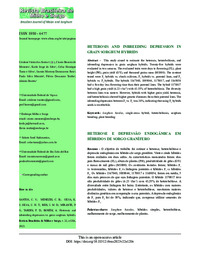Heterosis and inbreeding depression in grain sorghum hybrids.
Heterosis and inbreeding depression in grain sorghum hybrids.
Author(s): SANTOS, C. V. dos; MENEZES, C. B. de; SILVA, K. J. da; SILVA, C. H. T. e; REIS, I. M. D.; MIRANTE, P. S.; TARDIN, F. D.; BORÉM, A.
Summary: This study aimed to estimate the heterosis, heterobeltiosis, and inbreeding depression in grain sorghum hybrids. Twenty-five hybrids were evaluated in two seasons. The evaluated traits were days to flowering (FL), plant height (PH), grain yield (GY), and thousand grains mass (M1000). The contrast tested were F1 hybrids vs. check cultivars, F1 hybrids vs. parental lines, and F1 hybrids vs. F2 hybrids. The hybrids 1167048, 1099044, 1170017, and 1169054 had a five-day less flowering time than their parental lines. The hybrid 1170017 had a high grain yield (6.23 t ha-1) with 43.55% of heterobeltiosis. The diversity between lines was narrow. However, hybrids with higher grain yield, heterosis, and heterobeltiosis showed higher genetic distances from their parental lines. The inbreeding depression between F1 vs. F2 was 30%, indicating that using F1 hybrids seeds is worthwhile.
Publication year: 2023
Types of publication: Journal article
Unit: Embrapa Maize & Sorghum
Keywords: Heterobeltiose, Hibrido, Melhoramento Vegetal, Plant breeding, Sorgo
Observation
Some of Embrapa's publications are published as ePub files. To read them, use or download one of the following free software options to your computer or mobile device. Android: Google Play Books; IOS: iBooks; Windows and Linux: Calibre.
Access other publications
Access the Agricultural Research Database (BDPA) to consult Embrapa's full library collection and records.
Visit Embrapa Bookstore to purchase books and other publications sold by Embrapa.

